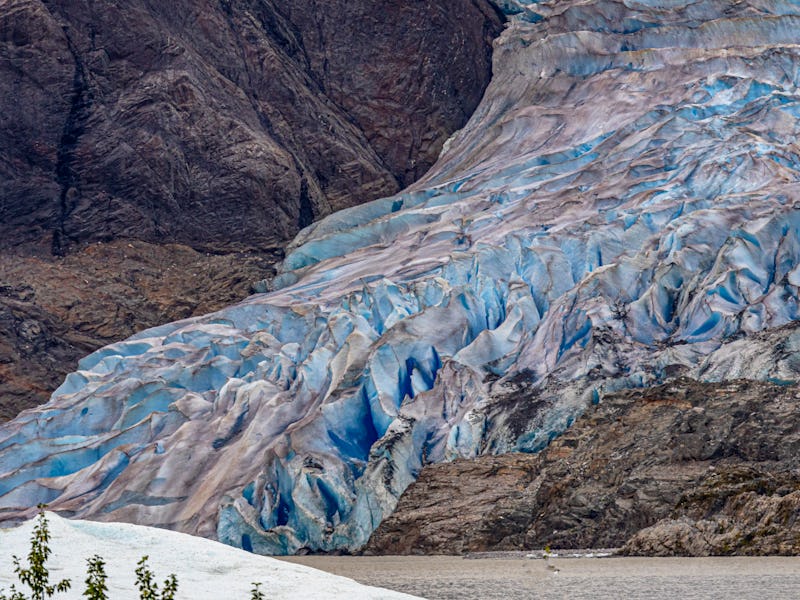Alaska’s Glaciers are Speeding Towards a Crucial Tipping Point
Here's why the old models got it so wrong.

Human-caused climate change is transforming the world at a lightning pace. New research reveals exactly what that means for Alaska’s glaciers and icefields. These critical bodies of frozen water are shrinking much faster than current models predict, and the rate of ice loss is accelerating rapidly, according to a study published July 2 in the journal Nature Communications. The science suggests icefields in Alaska and similar regions could soon reach a tipping point past which no amount of climate mitigation or greenhouse gas emissions could stop their decline, with unsettling implications for sea level rise.
“It’s incredibly worrying,” said Bethan Davies, lead study author and a glaciologist at Newcastle University in England in a statement. “The feedback processes this sets in motion [are] likely to prevent future glacier regrowth, potentially pushing glaciers beyond a tipping point into irreversible recession.”
More than 20 percent of global sea level rise results from mountain glaciers and ice cap melt and Alaska’s glaciers are already the largest single contributor among that portion. The new findings indicate that the state’s future contributions to rising tides may soon be baked-in, and impossible to prevent.
Davies and her co-authors combined historical aerial photographs, geologic data on the most recent glacial maxima, and satellite images to specifically quantify volume and area loss at one site, which likely carries implications for others. They focused their analysis on Juneau Icefield, a sprawling expanse composed of about 1,000 glaciers covering about 1,500 square miles on the Alaska/British Columbia border, and assessed how the formation changed between 1770 and 2020.
The scientists found some alarming trends. Following the end of the “Little Ice Age” that spanned from about 1300 to 1750, ice loss was relatively consistent between 1770 and 1979. During that period, Juneau Icefield lost between .65 and 1.01 cubic kilometers (0.16 to 0.24 cubic miles) of ice each year. Between 1979 and 2010, that rate increased to 3.08 to 3.72 cubic kilometers of ice loss annually. From 2010 to 2020, the rate of ice loss doubled in just a decade, rising to about 5.91 cubic kilometers per year. Zooming in on a narrower and more recent time period, losses accelerated even further between 2015 and 2020.
All of this has unfolded against the backdrop of increasing atmospheric greenhouse gas concentrations and rising average temperatures. Summer temperatures at Juneau Icefield were about 1 degree Celsus warmer, on average, from 2001 to 2020 than they were from 1941 to 1970. The mean winter temperature for the same time period is up more than 2 degrees C, lengthening the annual period of melt.
More than 20 percent of global sea level rise results from mountain glaciers and ice cap melt and Alaska’s glaciers are already the largest single contributor among that portion.
As of 2019, 100 percent of the glaciers mapped at Juneau Icefield were receding and 108 had disappeared completely. The total ice loss since the Little Ice Age maximum is estimated to be about 24.25 percent of the icefield’s volume. In addition to the loss of ice volume and area, the remaining ice field is becoming increasingly fragmented and vulnerable.
As the melt eats away at the ice field and its glaciers, several knock-on processes are triggered which can lead to feedback loops that, in turn, produce more melting. For one, Juneau Icefield (as with many Alaskan icefields) is relatively flat, so it’s losing volume all over. As this happens, it becomes less thick and, over time, the surface of the ice gets closer to sea level. At lower elevations, the air is warmer, and melting increases.
Another feedback loop occurs when fresh snow accumulation is reduced at lower altitudes, as the icefield surface gets farther away from the snowline. With less fresh snow, the icefield surface becomes dirtier and less reflective. These darker surfaces absorb more heat and additional melting ensues. Fragmentation that exposes rocks and gravel also reduces the reflectivity (or “albedo”) of the icefield, and enables hotter air to penetrate deeper into glaciers.
Each of these processes individually is “destabilizing”, write the study authors, and together they are even worse news. Scientists rely on mathematical and computer models to try to predict how ice losses are set to unfold under climate change. However, existing icefield models often don’t consider these sorts of feedback loops and fail to capture the depth, breadth, and speed of planetary modification underway.
Currently, models suggest that Juneau Icefield should be losing ice linearly through 2040, with losses only accelerating after 2070, but the new study indicates those models are flawed. “Current glacier projections may be too small and underestimate glacier melt in the future,” Davies said. If we want to understand what the coming decades hold, we’ll have to pay closer attention to the past.